| LANGA MANGANIAR RAJASTHAN | |
|
|
|
| The Langas and Manganiarsare groups of hereditary professional musicians, whose music has been supported by wealthy landlords and aristocrats for generations. Both sing in the same dialect, but their styles and repertoires differ, shaped by the tastes of their patrons. The monarchs of the courts of Rajput and Jaipur maintained large music and dance troupes an in an environment where the arts were allowed to flourish. Though both communities are made up of Muslim musicians, many of their songs are in praise of Hindu deities and celebrate Hindu festivals such as Diwali and Holi. The Manganiar performs traditionally invoke the Hindu god Krishna and seek his blessings before beginning their recital. At one time, the Manganiars were musicians of the Rajput courts, accompanying their chiefs to war and providing them with entertainment before and after the battles and in the event of his death, would perform at the ruler's vigil day and night until the mourning was over | |
| (Musical Instrument of Rajasthan) | |
.png) |
The Sindhi Sarangiused by the Langas, is made up of four main wires, with more than twenty vibrating sympathetic strings which help to create its distinctive haunting tones. The bowing of these instruments is a skilful exercise, often supported by the sound of the 'ghungroos' or ankle bells that are tied to the bow to make the beat more prominent. The word 'Manganiyar' means those who asks for alms. On different occasions they would go to patron's house and sing appropriate songs and in turn would be rewarded. The Manganiyar community is divided into two parts, one whose patrons are Hindus and the other who have Muslim patrons. The Hindu patrons mostly belong to Bhati and Rathore communities of Rajputs , the Muslims patrons are Sindhi Muslims. Even though the Manganiyars are Sunni Muslims by birth, their lifestyle and the way of dressing up reflect the Hindu or the 'Ganga-Jamana' culture. They present a perfect example of communal bonhomie as for generations they have been closely linked to both Muslims and Hindu families for their livelihood. Since generations the traditions of singing and composing for occasions is going strong. Singing at their jajmaans house on various occasions is their traditional profession. Describing their jajmaans illustrious history which is full of honor and pride, is their speciality. The descriptions of jajmaan's Genealogy with the support of artists is known as 'Shubhraj. Such is the ability of these people that they could recite all the names of the last few generations of the jajmaans within the space of a single breath. This also includes the descriptionsof their achievements. In exchange of the above, the manganiyars were rewarded handsomely in the form of grain, wheat, goat, camel, sheep, horse or cash |
| Kamaycha | |
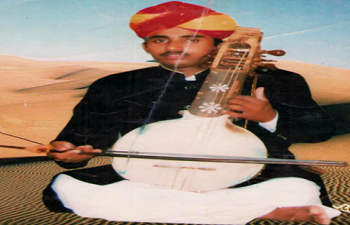 |
Kamaycha is a popular bow and string instrument, used by the folk artists belonging to the Manganiyar community of Rajsthan . This instrument is known for its deep booming sound. The Kamaycha contains a large sized circular resonator, the source of the booming sound. There are 3 strings, made of gut, used for producing the melody. Two strings made of brass gives the drone. Additionally, there are 15 sympathetic strings made of steel. The Kamaycha is held vertically while playing. |
| Morchang | |
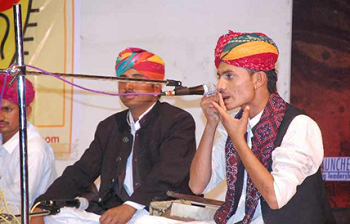 |
Morchang is the most favourite instrument for Langa community of Rajasthan, a wrought iron instrument, much akin to the Jews harp, which produces twanging sounds
|
| Dholak | |
 |
Dholak is a classical North Indian, Pakisthani and Nepalese hand drum. A dholak may have traditional lacing or turnbuckle tuning. The dholak has a simple membrane and a handle on the right hand side. The left hand membrane has a special coating on the inner surface. This coating is a mixture of tar, clay and sand (dholak masala) which lowers the pitch and provides a well defined tone. The wood used for the membrane is usually made of teak wood, also known as "sheesham" wood. The process of hollowing out the drum is the determination of the sound and quality of the dholak A dholak has 2 heads a small part for the high pitch, and the large part is for the low pitch and it's pitched depending on size and tuning sounding like a bongo in playing mode. |
| Khartaal | |
 |
Khartaal,the word mean Khar and Taal. Khar means hand and Taal means Rhythm. Rhythm of Hands. Khartaal is a kind of castanets, made of teak wood, and the artistes hold them in both hands and perform with tremendous ease. A young man's Karthal play holding it in his hands was a thrill to watch for the way he created complex percussion sounds, while his partner was playing the dholak |
| Double Flute (Algoja)Double Flute (Algoja) | |
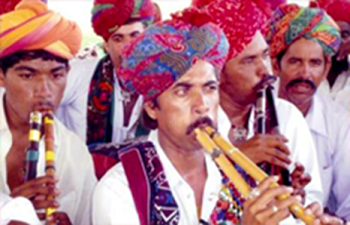 |
|
 |
Bhakti compositions Octogenarian Padmaram Meghwal mainly sings the bhajan of Mira, Kabir, Ramdeo, Tulasidas and Sadaram. I, somehow, believe I am from their clan, he says and resolves the differences between the two streams. Padmaram Meghwal is one of the finest singers in Barmer, where he lives. He learnt to play the tandura (veena) from his guru Sahja Bai Saadh with whom he lived for 10 years. Music is a source of emotional succour and connects him with God, he says. His haunting voice, coupled with the rich lyrics of Meera and other poets, makes his renditions a truly moving experience. Applauded by the illustrious folklorist and ethnomusicologist Komal Kothari several years ago, Padmaram specializes in singing for Jagrans, the all-night gatherings of devotional songs. He also sings in Sindhi. He still does riyaz and sings in a temple in his village. With time, my talent has risen to new heights but I can no longer perform the way I used to. Yet, growing older has not broken my confidence. |
| Child Artist | |
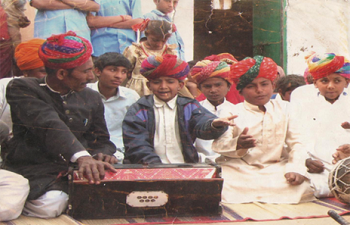 |
Langa and Manganiar are two Muslim ethnic groups living in the Thar desert in the west of Rajasthan. Their musicians play the traditional, semi-classical music of Western Rajasthan. They offer their musical skills to the communities where they play at important traditional celebrations such as births, marriages, rituals and other communal festivities. The communities are obliged to pay them and give them money, presents (e.g. jewellery) or part of their agricultural products in return for their services. These rules laid down in society 5 centuries ago have made it possible for the tradition to survive to the present day. Although both groups come from the same region, the Langas have played their music exclusively for the Muslims, who belong to the lower castes of the region (Jagirdars). The Manganiar have played for the Hindu Jagirdars and also for the kings of Western Rajasthan. This difference in audience continues even today, whereas the repertoire of the two groups has gradually become interchangeable
|
| Kalbeliya | |
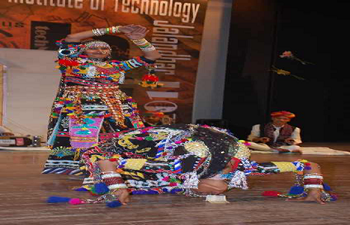 |
Kalbeliya is a Nomadic community who sometimes introduces themselves as Naath, Jogi,Sapere and Sadhu. Their family business is to catch snakes. This comes in handy as they showcase a number of tricks using these snakes while giving spectacular shows in nearby villages and qasbas and at their jajmaan's place and thus earn livelihood for themselves. As the time changed they have made permanent lodging outside the cities |
| Pungi | |
|
Pungi is a special instrument of Kalbeliya
community. They catch snakes with the help of Pungi.
They enchant the snake by playing this instrument
and then catch it. They believe that the snake can
never bite them and they also make \'Surma\' using
the snake\'s poison. Due to the use of Surma they
believe never lose their eye sight. |
|
| Bhavai Dance | |
 |
One of the state's most spectacular performance at consists of veiled women dancers balancing up to seven or nine brass pitchers as they dance nimbly, pirouetting and then swaying with the soles of their feet perched on the top of a class or on the edge of the sword. There is case of cutting edge suspense and nail biting acts in the dance.Dancers present this dance with 11 utensils on their on their head.one upon other. Not only this, the dance is presented on glass pieces, nails. Swords and also picking notes from land by lips.
|
| Teratali Dance | |
 |
Teratali dance is performed by the women of the kamad caste accompanied by men playing the Dholak, Manjira & Tandura. They tie Manjira (cymbals) to their body and play with dexterity with hands. This dance form is attached to devotional and ritualistic practice of worshiping baba ramdeo who is believed to have lived around the beginning of the 16th century and emerged as god for the down trodden and hierarchically low castes. The women sing and dance in praise of Ramdeo and his miracles. Their patrons castes are meghwal and Nath. |
| Puppetry | |
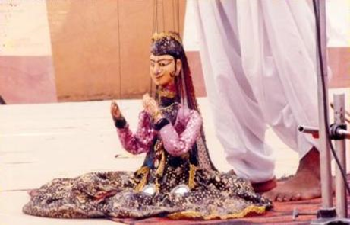 |
In Rajasthan, there is only one tradition of puppetry-the marionette tradition-in which the puppets are manipulated by strings. We have no examples of shadow or glove puppetry. I t is possible that this string puppet tradition could have migrated all the way from Rajasthan to Maharashtra, Karnataka and west Bengal, but we can't be sure. In fact, there is no clear evidence about the origins of puppetry in Rajasthan itself. All that we have are some legendary stories that pass off as history
|
| Kachi Ghodi Dance | |
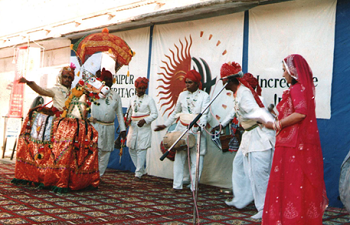 |
The centuries of history that has piled up behind Rajasthan has resulted, among other things, in the accumulation of a very rich folk culture. The Kachi Ghodi Dance Rajasthan is one of the most popular Folk Dances In Rajasthan. The Kachi Ghodi Dance In Rajasthan India is performed on dummy horses. Men in elaborate costumes- red turbans and dhotis and kurtas ride the well decorated dummy horses. With naked swords in their hands, these dancers move rhythmically to the beating of drums and fifes while a singer narrates the exploits of the Bavaria bandits of Shekhawati. This dance is always performed by men. The performing arts of Rajasthan mostly hail from the tribes of Rajasthan and are reflective of the socio historical scenario peculiar to the time or race they depict. Horses have always been a very important part of warfare and transportation in Rajasthan. The legend of the valiant Rana Pratap Singh goes untold without the mention of his loyal vehicle- Chetak. Horses, as much as they were the symbol of royal power, were also used by the bandits and highwaymen who found it easy to stop people traveling on elephants of bullock carts with their horses. Specially, notorious were the bandits of the Shekhawati region, owing mostly to the high concentration of businessmen and traders in that part of Rajasthan. And traders meant money; and traders meant long overnight journeys on caravans laden with expensive wares. The Kachi Ghodi Dance Rajasthan depicts the confrontation of the bandits of the Bavaria clan of tribes with the passing commoners |
|
Agani Ger Dance |
|
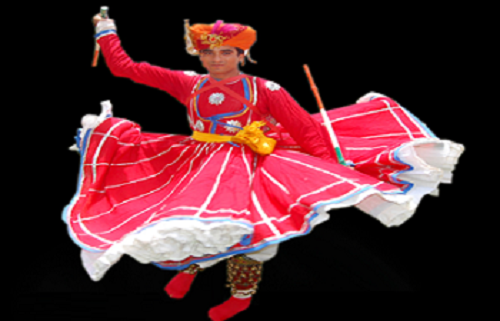 |
Many different type of dance in the thar dance. In Ancient the unque dress of the king. In king dress a name of cloth which is aangi. This is the 40 mtr. Cotton cloth. In the ancient time people say Pchuta of the cloth. Its very waitful. They are dress up the red color vanga on the above of the aangi. The vaga's size are the 10 mtr. On the front of the vanga white wire and white flowers. They use to tarban. On the tarban kalangi,tura and small-small turiya are fixed. They are put-on the leather belt on the west. They put-on sword in the hend and they put_on dhal on our back. The total wait of the dress are 20 to25 kg. This dress only for king |
| Chari dance | |
 |
Chari is a popular folk dance of Kanjar tribe, inhabiting parts of Kota District in Rajasthan. This dance is performed exclusively by the womenfolk of this tribe, forming their main source of livelihood. Almost all the marriages and festive occasions in the region feature a performance of this dance form. It involves a series of fast spinning movements done to the beats of the Dholak. This dance is accompanied by traditional songs. |

